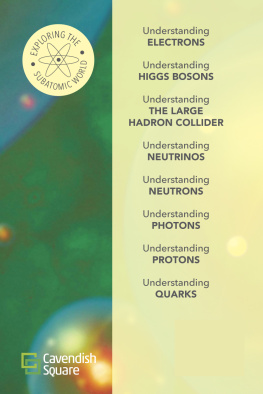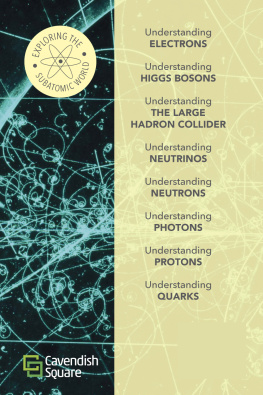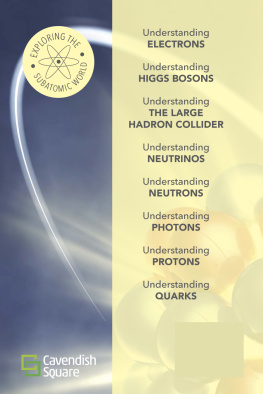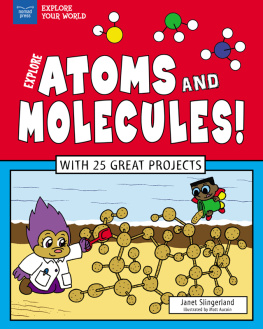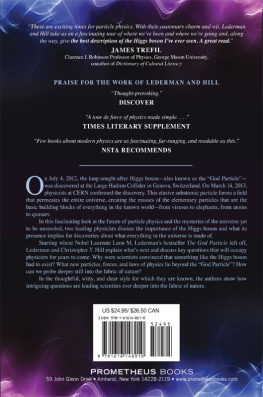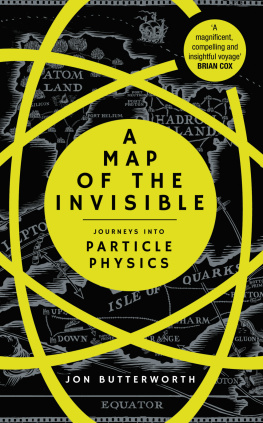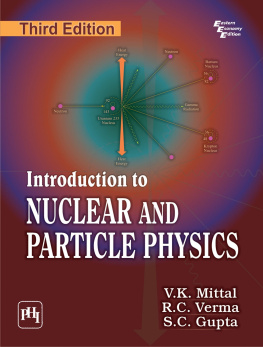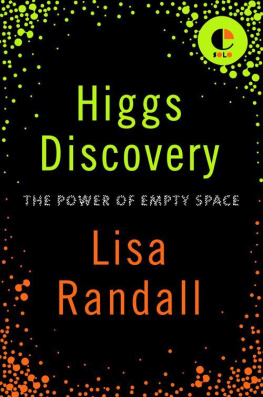B. H. Fields - Understanding Protons
Here you can read online B. H. Fields - Understanding Protons full text of the book (entire story) in english for free. Download pdf and epub, get meaning, cover and reviews about this ebook. year: 2015, publisher: Cavendish Square Publishing, LLC, genre: Romance novel. Description of the work, (preface) as well as reviews are available. Best literature library LitArk.com created for fans of good reading and offers a wide selection of genres:
Romance novel
Science fiction
Adventure
Detective
Science
History
Home and family
Prose
Art
Politics
Computer
Non-fiction
Religion
Business
Children
Humor
Choose a favorite category and find really read worthwhile books. Enjoy immersion in the world of imagination, feel the emotions of the characters or learn something new for yourself, make an fascinating discovery.
- Book:Understanding Protons
- Author:
- Publisher:Cavendish Square Publishing, LLC
- Genre:
- Year:2015
- Rating:3 / 5
- Favourites:Add to favourites
- Your mark:
- 60
- 1
- 2
- 3
- 4
- 5
Understanding Protons: summary, description and annotation
We offer to read an annotation, description, summary or preface (depends on what the author of the book "Understanding Protons" wrote himself). If you haven't found the necessary information about the book — write in the comments, we will try to find it.
Readers will explore the history of the discovery and the properties of the proton, the positively charged subatomic particle that, with the neutron, makes up an atoms nucleus.
Understanding Protons — read online for free the complete book (whole text) full work
Below is the text of the book, divided by pages. System saving the place of the last page read, allows you to conveniently read the book "Understanding Protons" online for free, without having to search again every time where you left off. Put a bookmark, and you can go to the page where you finished reading at any time.
Font size:
Interval:
Bookmark:



To Alex, with every positive wish.
Published in 2016 by Cavendish Square Publishing, LLC
243 5th Avenue, Suite 136, New York, NY 10016
Copyright 2016 by Cavendish Square Publishing, LLC
First Edition
No part of this publication may be reproduced, stored in a retrieval system, or transmitted in any form or by any meanselectronic, mechanical, photocopying, recording, or otherwisewithout the prior permission of the copyright owner. Request for permission should be addressed to Permissions, Cavendish Square Publishing, 243 5th Avenue, Suite 136, New York, NY 10016.
Tel (877) 980-4450; fax (877) 980-4454.
Website: cavendishsq.com
This publication represents the opinions and views of the author based on his or her personal experience, knowledge, and research. The information in this book serves as a general guide only. The author and publisher have used their best efforts in preparing this book and disclaim liability rising directly or indirectly from the use and application of this book.
CPSIA Compliance Information: Batch #WS15CSQ
All websites were available and accurate when this book was sent to press.
Library of Congress Cataloging-in-Publication Data
Bortz, Fred, 1944- author.
Understanding protons / Fred Bortz and B.H. Fields.
pages cm (Exploring the subatomic world)
Includes bibliographical references and index.
ISBN 978-1-50260-546-7 (hardcover) ISBN 978-1-50260-547-4 (ebook)
1. ProtonsJuvenile literature. 2. Particles (Nuclear physics)Juvenile literature.
I. Fields, B. H., author. II. Title. III. Series: Exploring the subatomic world.
QC793.5.P72B68 2015
539.72123dc23
2015003670
Editorial Director: David McNamara
Editor: Andrew Coddington
Copy Editor: Cynthia Roby
Art Director: Jeff Talbot
Designer: Stephanie Flecha
Senior Production Manager: Jennifer Ryder-Talbot
Production Editor: Renni Johnson
Photo Research: J8 Media
The photographs in this book are used by permission and through the courtesy of: MARK GARLICK/Science Photo Library/Getty Images, cover; Monika Wisniewska/ Shutterstock.com, throughout; DeAgostini/Getty Images, 7; Universal History Archive/ UIG/Getty Images, 8; Welcome trust/File:Distillatio, scene in an alchemist laboratory Wellcome M0018149.jpg/Wikimedia Commons, 10; Georgios Kollidas/Shutterstock.com, 11; chemistryland.com/File:Gaylussac.jpg/Wikimedia Commons, 13; Thomas Forget,
14; SSPL/Getty Images, 17; Magnetix/Shutterstock.com, 18; Thomas Forget, 20; Thomas Forget, 23; George Grantham Bain Collection (Library of Congress)/File:Ernest Rutherford LOC.jpg/Wikimedia Commons, 24; Kurzon/File:Gold foil experiment conclusions.svg/ Wikimedia Commons, 26; Trambitskiy Yury/Shutterstock.com, 27; Thomas Forget, 30-31; Thomas Forget, 32; Elliott & Fry/Hulton Archive/Getty Images, 35; Keystone/Getty Images, 37; Bernard Miller/NASA, 40; MASIL Imaging Team/NASA, 43; Jon Brenneis/The LIFE Images Collection/Getty Images, 45; David Levenson/Getty Images, 45; Thomas Forget, 47; NASAs Goddard Space Flight Center, 49; Jupeart/Shutterstock.com, 50; Rob Atkins/Photographers Choice/Getty Images, 51; Reactor-Sean Gallup/Getty Images, 53.
Printed in the United States of America
Contents
Atoms, Molecules, and Matter
Discovering the Nucleus
Particles Within the Nucleus
Protons and Nuclear Fusion
W hat is matter? That is one of oldest questions in science. It is also among the most productive, because as we learn more about matter, we also find new questions.
For example, you probably know that every substance on Earth is made of atoms and combinations of atoms called molecules. But do you know what makes hydrogen different from nitrogen? What makes carbon different from silicon? What makes what makes any one kind of atom different from any other?
The scientific theory of atoms goes back to 1803, when John Dalton (17661844) adopted an idea of the ancient Greek philosophers Leucippus and Democritus. Twenty-three centuries earlier, long before modern science, they imagined cutting up a piece of matter until it was atomos, meaning indivisible.
Dalton used that notion of indivisible particles to interpret laboratory observations. In Daltons theory, the atoms of Leucippus and Democritus turn out to be molecules. A water molecule is made of two hydrogen atoms and one oxygen atom, and is therefore not indivisible. But it is the smallest unit of matter that can still be called water. Dalton spoke of elements, which are made of only one kind of atom, and compounds, which are made of only one kind of molecule.
Daltons theory still considered atoms indivisible, but as more scientists discovered more elements, it was natural to wonder if the atoms were made of even smaller particles that distinguished one kind of atom from another. By the end of the nineteenth century, physicists (scientists who study matter and energy) began to discover those subatomic particles. And in the early twentieth century they realized that one of the most important of those was the proton.
This book is the story of how protons were discovered, where our understanding of protons has led us, and what lies ahead.
ATOMS,
Molecules, and Matter
T he ancient idea that matter is made up of tiny, indivisible pieces has led scientists in directions that Leucippus and Democritus could never have imagined. Todays world of human-made substances depends on our knowledge of atoms, the subatomic particles within those atoms, and the forces that hold them together or break them apart.
Those ancient Greek philosophers began with two simple questions: What is matter made of, and why do different kinds of matter behave so differently from each other? When they imagined dividing everyday substances into smaller and smaller bits until the pieces were indivisible atoms, they also decided that the atoms of each substance would have a particular shape and texture. For instance, they concluded that water atoms would be round and smooth, while rock atoms would be hard and sharp or gritty.
The presumed atoms were much too tiny for the Greeks to test their ideas. Besides, the notion of testing theories by observation, a cornerstone of modern science, was not yet part of human culture. Toward the end of Democritus life, Greek philosophy entered what is often called a golden era, where great thinkers such as Socrates, Aristotle, and Plato used their powerful minds and logic to deduce what they believed to be the truth about the natural world.
Aristotle was so brilliant in many fields that his ideas were rarely questioned. For nearly two thousand years, most people accepted his conclusion that all the worlds matter was made of four elements: earth, air, fire, and water. The idea of atoms all but disappeared. Today we know that both Democritus and Aristotle were right in general but wrong in detail.

Democritus. This sculpture depicts Democritus, the founder of an ancient Greek philosophical movement known as atomism. He proposed that matter is made of tiny indivisible particles, an idea that eventually led to the modern theory of atoms.
Font size:
Interval:
Bookmark:
Similar books «Understanding Protons»
Look at similar books to Understanding Protons. We have selected literature similar in name and meaning in the hope of providing readers with more options to find new, interesting, not yet read works.
Discussion, reviews of the book Understanding Protons and just readers' own opinions. Leave your comments, write what you think about the work, its meaning or the main characters. Specify what exactly you liked and what you didn't like, and why you think so.

